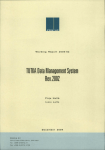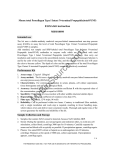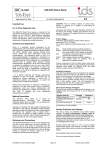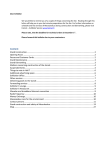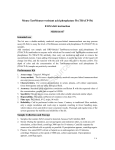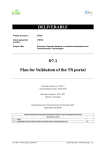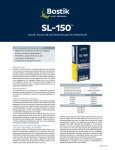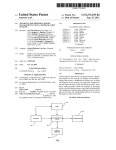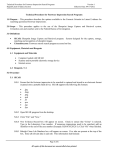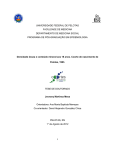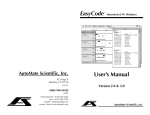Download Précautions d`utilisation du produit :
Transcript
REF IS-4000 Instructions for Use IDS-iSYS Intact PINP IN VITRO DIAGNOSTIC plumbing to form highly explosive metal azides. On disposal, flush with large volumes of water to prevent azide build up. Intended Use For In Vitro Diagnostic Use The IDS-iSYS Intact amino-terminal propeptide of type I procollagen (Intact PINP) assay is intended for the quantitative determination of intact PINP in human serum or plasma on the IDS-iSYS Multi-Discipline Automated Analyser. Summary and Explanation An important step in the bone formation process is synthesis of type I collagen, which is the major organic component in bone matrix. During collagen synthesis, propeptides are released from both the amino- and the carboxyterminal parts of the procollagen molecule 1. These propeptides are secreted into the blood circulation. The amino-terminal propeptide of type I procollagen (PINP) is probably the most specific and sensitive marker of bone formation 2. PINP is a particularly useful marker for monitoring the efficacy of osteoporosis therapy with anabolic agents 3,4, but it is also one of the best bone turnover markers for monitoring the efficacy of antiresorptive therapy 4,5. Method Description This assay is based on chemiluminescence technology. Samples and calibrators are diluted in a diluent and a portion of this is incubated with a biotinylated anti-PINP monoclonal antibody, an acridinium labelled monoclonal antibody, streptavidin labelled magnetic particles and an assay buffer. The magnetic particles are captured using a magnet and a wash step performed. Trigger reagents are added and the resulting light emitted by the acridinium label is directly proportional to the concentration of intact PINP in the original sample. Warnings and Precautions The IDS-iSYS Intact PINP is for in vitro diagnostic use only and is not for internal use in humans or animals. This product must be used strictly in accordance with the instructions set out in these Instructions for Use (IFU). IDS Ltd. will not be held responsible for any loss or damage (except as required by statute), howsoever caused arising out of non-compliance with the instructions provided. CAUTION: This kit contains material of animal origin. Handle kit reagents as if capable of transmitting an infectious agent. Appropriate precautions and good laboratory practice must be used in the storage, handling and disposal of the kit reagents. Disposal of kit reagents should be in accordance with local regulations. Sodium Azide Xn. Harmful: Calibrators CAL contain sodium azide (NaN 3 ) >0.1 % (w/w) (<1 %). R22 R52/53 S46 S36/37 S60 Harmful if swallowed. Harmful to aquatic organisms, may cause longterm adverse effects in the aquatic environment. If swallowed, seek medical advice immediately and show this container or label. Wear suitable protective clothing and gloves. This material and/or its container must be disposed of as hazardous waste. Some reagents in this kit contain sodium azide as a preservative, which may react with lead, copper or brass IS-4000PLV02, 2009-12-22, English Page 1/4 Handling Precautions Apart from the calibrators, which are lyophilised, the reagents provided in the kit are ready to use. Refer to the Calibrator section of the procedure for reconstitution methodology. Before a new cartridge is loaded onto the Analyser, the magnetic particle container requires mixing by the operator with a brisk rotation motion. This will resuspend the magnetic particles that have settled during shipment. It is very important to avoid any foam formation. Shelf Life and Storage of Reagents Prior to first use, store the cartridge and the calibrators in an upright position in the dark at 2 - 8 °C. Do not freeze the cartridge or the calibrators. Reagent shelf life Cartridge Before opening at 2 - 8 °C Cartridge, after opening at 2 - 8 °C Calibrators, after reconstitution at 2 - 8 °C On board the Analyser (*) Calibrators To the expiry date 28 Days N/A N/A 4 weeks 7 Days 3 hours (*) Continuous on board stability. Sample Collection and Storage The assay should be performed using serum (standard sampling tubes or tubes containing serum separating gel) or plasma (lithium heparin, sodium heparin, ammonium heparin or potassium EDTA) samples. Samples should be separated as soon as possible after collection. Store samples at -20 °C. Avoid repeated freeze - thaw of samples. Samples containing particulate matter must be centrifuged before performing the assay. Do not use heat-inactivated samples. To minimise possible evaporation effects, samples, calibrators, and controls should be measured within 3 hours of being placed on the Analyser. Before performing assays, make sure that samples, calibrators and controls are at room temperature (20 - 25 °C). Note: Some sample collection tubes that are commercially available might affect the results of testing in particular cases. It is recommended to follow the instructions of the tube manufacturer especially when processing samples in primary tubes. Procedure Materials Provided Reagent Cartridge MPS3 Magnetic particles coated with streptavidin in phosphate BSA buffer with sodium azide as preservative (<0.1 %), 1 bottle, 2.3 mL. CONJ Anti-PINP monoclonal antibody labelled with an acridinium ester derivative, in buffer containing bovine, and mouse proteins with sodium azide as preservative (<0.1 %), 1 bottle, 4.95 mL. Device code : IS-4000 REF IS-4000 Instructions for Use IDS-iSYS Intact PINP IN VITRO DIAGNOSTIC Ab-BIO Anti-PINP monoclonal antibody labelled with biotin, in buffer containing mouse and bovine proteins with sodium azide as preservative (<0.1 %), 1 bottle, 16.8 mL. BUF Buffer containing mouse and bovine proteins, with sodium azide as preservative (<0.1 %), 1 bottle, 4.95 mL. DIL Buffer containing sodium azide as preservative (<0.1 %), 1 bottle, 23.7 mL. Calibrators CAL A CAL B Lyophilised buffer containing BSA with <1.0 % sodium azide as preservative (<0.05 % reconstituted). 2 each of 2 concentration levels, 1.0 mL per bottle. Mini CD Contains IFU for IDS-iSYS reagents, control ranges and XML files. Materials Required But Not Provided IDS-iSYS Multi-Discipline Automated Analyser: IS-310400 IDS-iSYS PINP Control Set: IS-4030, 2 x 1.0 mL each of levels 1, 2, and 3. IDS-iSYS Cuvettes Cube: IS-CC100, box of 960 cuvettes. IDS-iSYS System Liquid: IS-CS100, 5 L container, ready to use. IDS-iSYS Wash Solution: IS-CW100, 10 L container, ready to use. IDS-iSYS Triggers Set A and B: IS-CT100, 2 x 250 mL per bottle, ready to use. IDS-iSYS Cartridge Check System: IS-6010, ready to use. IDS-iSYS Sample Cups (500 µL): IS-SC105. Procedure Reagent Cartridge The reagents provided in the cartridge are ready to use. The Analyser automatically performs the mixing of magnetic particles to maintain homogeneity. Before a new cartridge is loaded on board the Analyser, mix the magnetic particles container by brisk rotation motion. Avoid foam formation. The barcode is read when the cartridge is loaded on the reagent tray. If the label cannot be read by the Analyser barcode reader, a manual procedure exists to enter the barcode data (see the IDS-iSYS User Manual). Load the cartridge on the reagent tray and wait for at least 40 minutes before starting the assay. If the cartridge is removed from the reagent tray, store the cartridge upright at 2 - 8 °C in the dark. Calibrators The Intact PINP calibrators are lyophilised. Reconstitute immediately before use. Add 1.0 mL of distilled or deionised water to each bottle. Replace the stopper. Leave for 10 minutes to reconstitute with occasional gentle mixing by hand. Avoid formation of foam. Pipette approximately 200 μL of calibrators and controls into sample cups and place on the machine. Discard the material in the sample cups after use. Proceed according to the instructions of the IDS-iSYS User Manual. DO NOT return material to the calibrator vial. IS-4000PLV02, 2009-12-22, English Page 2/4 Analyser Calibration The two Intact PINP calibrators are required to perform the adjustment of the master curve. The calibrators are supplied with the kit and calibrators from another lot must not be used. Note that to perform a master curve adjustment controls MUST be run at the same time as the calibrators. All data required for the calibration of the cartridge batch can be found on the mini CD. Use calibrator levels A and B to adjust the master curve to the reagents on board the Analyser. Check for the presence of an Intact PINP cartridge on the reagent tray and the availability of the cartridge master curve in the database. If the data for the lot of calibrators is not available on board the Analyser, load the data using the mini CD provided with the calibrator. Start the immunoassay calibration on the IDS-iSYS Analyser according to the IDS-iSYS User Manual. The calibration is carried out in triplicate. RLU CVs of >5 % will result in a failed calibration. One replicate may be removed to meet the calibration requirements. As stated above, please note that controls must also be run. Verify and approve the calibration according to the calibration status displayed in the calibration windows and discard the calibrator from the sample tray after use. Calibration The calibrators of this kit are traceable to the manufacturer’s working calibrators which are prepared from highly purified PINP whose value is assigned using amino acid composition analysis. Calibration Frequency A new calibration is required: • Each time a new lot of cartridges is loaded on board. • Each time a new lot of trigger or cuvettes is used. • When the control values do not fall within the defined ranges. • When the calibration has expired. • After Analyser service. Verification of the calibration is automatic and managed by the Analyser. Quality Control Use the IDS-iSYS Intact PINP Control Set for quality control. To ensure validity of results at least three controls with varying levels of intact PINP should be measured. Other suitable control material can be used in addition to the IDS-iSYS Intact PINP Control Set. Controls should be tested at (or near) the beginning of every run containing patient samples and also during calibrations, or according to local regulations. It is recommended that the controls be routinely run in duplicate. Laboratories should test controls at least once per shift. Refer to the IDS-iSYS Intact PINP Control Set IFU for preparation and handling instructions. Determination of Sample intact PINP levels Process samples according to the IDS-iSYS User Manual. Device code : IS-4000 IDS-iSYS Intact PINP REF IS-4000 Instructions for Use IN VITRO DIAGNOSTIC Calculation of Results The intact PINP concentration of each sample is calculated automatically. The display of the concentrations (screen or printed) is produced upon user request. The IDS-iSYS Intact PINP Assay uses a 4-parameter logistic curve fit (4PL) to calculate the intact PINP concentrations. Measurement Range (Reportable Range) The reportable range of the assay is 2 - 230 ng/mL. Any value that reads below 2 ng/mL should be reported as “< 2 ng/mL”. Dilution Samples with intact PINP concentrations above the reportable range should be diluted manually with a low concentration human serum sample in a ratio of 1 in 2. The results for diluted samples must be multiplied by the dilution factor 2 and corrected for the concentration of the low sample. Limitations of Use 1. As in the case of any diagnostic procedure, results must be interpreted in conjunction with the patient’s clinical presentation and other information available to the physician. 2. The performance characteristics of this assay have not been established in a paediatric population. 3. The following substances do not interfere in the IDS-iSYS Intact PINP Assay when the concentrations presented in the following table are below the stated threshold. Potentially Interfering Agent Lipid Bilirubin Haemoglobin Biotin 4. Threshold Concentration 2803 mg/dL 200 mg/dL 500 mg/dL 300 nmol/L The hook effect was tested using concentrations of PINP up to 2350 ng/mL. No hook effect was observed. Expected Values Each laboratory should determine ranges for their local population. The following range was determined using the IDS-iSYS Intact PINP Assay and is provided for information only. The 95 % reference interval for normal adults, collected from 150 apparently healthy adults, was calculated by a non-parametric method following the NCCLS guideline C28-A2, “How to Define and Determine Reference Intervals in the Clinical Laboratory”. Detection and Limits of Quantitation” using 60 blanks and 120 low level samples. LoB LoD LoQ 0.5 ng/mL <1.0 ng/mL <1.0 ng/mL Precision Precision was evaluated in accordance with a modified protocol based on CLSI EP-5A2, “Evaluation of Precision Performance of Quantitative Measurement Methods”. Three serum controls were assayed using three lots of reagents in quadruplicate once per day for 20 days on two analysers. Control n mean Within-run Total (ng/mL) SD CV% SD CV% 1 80 14.3 0.4 2.6 0.6 4.2 2 80 44.6 1.3 3.0 2.4 5.3 3 80 100.9 3.0 3.0 4.5 4.4 Recovery Recovery was assessed by adding intact PINP to samples prior to assay. Sample PINP Measured Recovery Recovery Conc added ng/mL ng/mL % ng/mL ng/mL 44.3 35.3 77.1 32.8 93 44.3 74.8 115.1 70.8 95 33.5 35.3 32.9 93 66.4 33.5 74.8 68.0 91 101.5 37.3 35.3 33.5 95 70.8 37.3 74.8 67.9 91 105.2 Mean 93 Linearity Linearity was evaluated based on CLSI EP-6A, “Evaluation of the Linearity of Quantitative Measurement Procedures: A Statistical Approach”. Samples containing varying concentrations of intact PINP were assayed in duplicate. The resulting mean concentrations were compared to predicted concentrations. Samples were prepared by diluting a high patient sample with a low patient sample prior to assay. Predicted Concentration (ng/mL) Measured Concentration (ng/mL) Variation (ng/mL) % 5.8 7.6 1.8 30.5 31.5 0.9 3 55.3 55.0 -0.2 0 80.0 78.4 -1.6 -2 104.8 101.9 -2.9 -3 Performance Data 129.6 127.2 -2.4 -2 Representative performance data are shown. Results obtained at individual laboratories may vary. 154.3 158.0 3.7 2 179.1 179.0 0.0 0 Sensitivity The limit of blank (LoB), limit of detection (LoD) and limit of quantitation (LoQ) were determined with guidance from CLSI EP17-A, “Protocols for Determination of Limits of 203.8 204.6 0.7 0 Normal Adults 27.7 - 127.6 ng/mL (n=150) IS-4000PLV02, 2009-12-22, English Page 3/4 Device code : IS-4000 REF IS-4000 Instructions for Use IDS-iSYS Intact PINP IN VITRO DIAGNOSTIC Method Comparison The IDS-iSYS Intact PINP Assay was compared against a recognised radioimmunoassay for the quantitative determination of intact PINP, following CLSI EP-9A2, “Method Comparison and Bias Estimation Using Patient Samples”. A total of 363 samples, selected to represent a wide range of intact PINP concentrations [8.7-230 ng/mL], was assayed by each method. Linear regression analysis was performed on the comparative data: IDS-iSYS = 0.86 RIA - 1.9 (95 % CI of the slope and intercept were 0.84 to 0.88, and -3.4 to -0.3, respectively); correlation coefficient (r) = 0.98. Specificity The specificity was assessed with the following analytes. Analyte Intact PINP Rat / mouse PINP PIINP N-mid Osteocalcin Cross-Reactivity 100% <0.01% <0.03% <0.02% e-mail: [email protected] • www.idsplc.com Germany Immunodiagnostic Systems GmbH (IDS GmbH), Mainzer Landstrasse 49, 60329 Frankfurt am Main. Tel.: +49 69 3085-5025 • Fax: +49 69 3085-5125 e-mail: [email protected] • www.idsplc.com France Immunodiagnostic Systems (IDS), 153 Avenue D’Italie, 75013 Paris, France Tel.: (0)1 40 77 04 50 • Fax : (0)1 40 77 04 55 e-mail: [email protected] • www.idsplc.com Scandinavia Immunodiagnostic Systems Nordic a/s (IDS Nordic a/s), Marielundvej 30, 2. Sal, 2730 Herlev, Danmark Tel:+45 44 84 0091 e-mail: [email protected] • www.idsplc.com Belgium Immunodiagnostic Systems S.A., Rue E. Solvay 101, 4000 Liège, Belgium Tel.: +32 4 252 26 36, Fax : +32 4 252 51 96 e-mail: [email protected] • www.idsplc.com Bibliography 1. 2. 3. 4. 5. Risteli J, Risteli L 2006 Products of bone collagen metabolism. In: Seibel MJ, Robins SP, Bilezikian JP, editors. Dynamics of bone and cartilage metabolism. Principles and clinical applications, second edition. London: Academic Press p391-405. Melkko J, Kauppila S, Niemi S, Risteli L, Haukipuro K, Jukkola A, Risteli J 1996 Immunoassay for intact amino-terminal propeptide of human type I procollagen. Clin Chem 42:947-954. Chen P, Satterwhite JH, Licata AA, Lewiecki EM, Sipos AA, Misurski DM Wagman RB 2005 Early changes in biochemical markers of bone formation predict BMD response to teriparatide in postmenopausal women with osteoporosis. J Bone Miner Res 20:962-970. Finkelstein JS, Leder BZ, Burnett SA, Wyland JJ, Lee H, De la Paz AV, Gibson K Neer RM 2006 Effects of teriparatide, alendronate, or both on bone turnover in osteoporotic men. J Clin Endocrinol Metab 91:2882-2887. Nenonen A, Cheng S Ivaska KK, Alatalo SL, Lehtimaki T, Schmidt-Gayk H, Uusi-Rasi K, Heinonen A, Kannus P, Sievanen H, Vuori I, Vaananen HK, Halleen JM 2005 Serum TRACP 5b is a useful marker for monitoring alendronate treatment: comparison with other markers of bone turnover. J Bone Miner Res 20: 1804-1812. Immunodiagnostic Systems Ltd (IDS Ltd), 10 Didcot Way, Boldon Business Park, Boldon, Tyne & Wear, NE35 9PD, England Tel.: +44 191 519 0660 • Fax: +44 191 519 0760 e-mail: [email protected] • www.idsplc.com Immunodiagnostic Systems UK Immunodiagnostic Systems Ltd (IDS Ltd), 10 Didcot Way, Boldon Business Park, Boldon, Tyne & Wear, NE35 9PD, England Tel.: +44 191 519 0660 • Fax: +44 191 519 0760 e-mail: [email protected] • www.idsplc.com USA Immunodiagnostic Systems Inc. 8425 N. 90th Street, Suite 8, Scottsdale, AZ 85258 Tel.: 1 480.278.8333 • Fax: 1 480.836.7437 IS-4000PLV02, 2009-12-22, English Page 4/4 Device code : IS-4000




